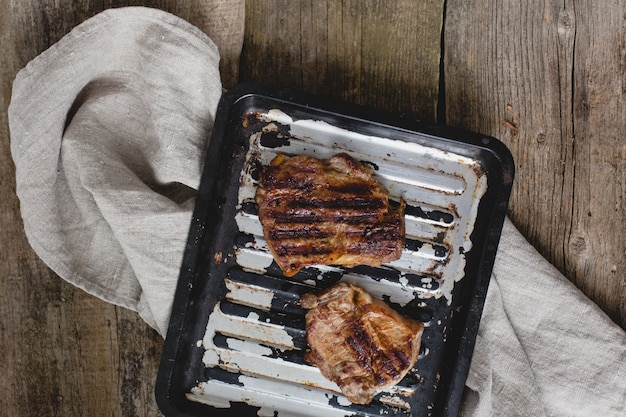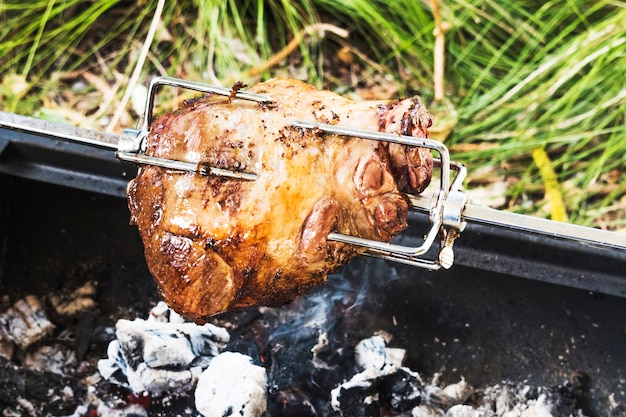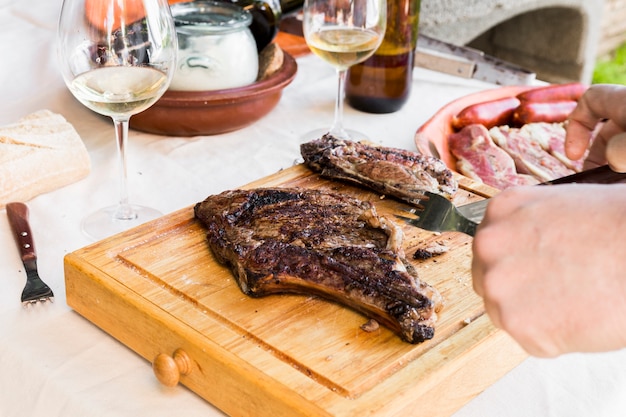You've got a magnificent rib roast, all gleaming and ready to grace your table. Visions of crispy edges, juicy pink centers, and the heavenly aroma that'll fill your home are already dancing in your head. But before you pop it in the oven, let's talk cooking time. It's the key to transforming that raw beauty into a culinary masterpiece.
Now, I'm no stranger to the kitchen. I've spent years honing my skills, and rib roasts are one of my favorite things to cook. I've learned a thing or two about getting that cooking time just right. So, grab a cuppa, get comfortable, and let me share my secrets. We're going to explore the world of rib roast cooking time, pound by pound, and I'll even throw in some tips to elevate your roast to the next level.
(Part 1) Understanding the Basics of rib roast cooking time

Before we dive into the nitty-gritty of calculating cooking time, let's get grounded in the fundamentals. Rib roasts are substantial cuts of meat, demanding a good amount of time to cook through properly. Think of it like a slow dance: the heat needs to caress the meat, coaxing out its tenderest, most delicious self.
The Importance of Cooking Time
Cooking time is the linchpin of a perfectly cooked rib roast. Undercook it, and you'll be left with a tough, chewy disappointment. Overcook it, and it'll be dry as a bone – not a pleasant dining experience! A well-cooked rib roast will be juicy, bursting with flavor, and melt-in-your-mouth tender. That's what we're aiming for.
Factors Affecting Cooking Time
You might be thinking, "Isn't there a magic formula for cooking time?" Well, not exactly. A few factors come into play, influencing how long your roast needs to spend in the oven. Let's break it down:
- Size of the Roast: It's a simple fact: the larger the roast, the longer it'll take to cook through. The heat has more meat to conquer!
- Desired Doneness: Do you prefer your roast medium-rare, medium-well, or well-done? The level of doneness you crave will directly impact the cooking time.
- Bone-in or Boneless: Bone-in roasts will take a bit longer to cook because that bone acts like a little heat sink, absorbing some of the oven's warmth. Boneless roasts cook faster since they don't have that bone-in barrier.
- Cooking Method: Are you roasting it in a traditional oven or embracing the slow-cooker life? The method you choose will impact the overall cooking time.
- Oven Temperature: A high oven temperature means a shorter cooking time. A lower oven temperature means a longer cooking time. This is all about the intensity of the heat wave your roast is facing.
(Part 2) Using the Per Pound Rule for Cooking Time

Now, let's get into the heart of the matter: figuring out your cooking time per pound. This is a trusty starting point for estimating how long your rib roast needs in the oven.
The General Rule of Thumb
A good rule of thumb is to allow 15-20 minutes per pound for a rib roast cooked at 325°F (160°C). Think of this as your baseline, your starting point for calculating the perfect time.
Adjusting for Desired Doneness
Now, that baseline time is for a medium-rare roast. If you're aiming for a more well-done roast, you'll need to add a few extra minutes per pound. Let's clarify those adjustments:
- Rare: 130-135°F (54-57°C), add 5 minutes per pound
- Medium-Rare: 135-140°F (57-60°C), add 10 minutes per pound
- Medium: 140-145°F (60-63°C), add 15 minutes per pound
- Medium-Well: 145-150°F (63-66°C), add 20 minutes per pound
- Well-Done: 150-160°F (66-71°C), add 25 minutes per pound
(Part 3) Calculating Cooking Time for Your Rib Roast

Okay, let's put this per pound rule into practice with a real-life scenario. Imagine you have a 4-pound rib roast and you're craving a medium-rare masterpiece.
Step-by-Step Calculation
1. Start with your base cooking time – 15-20 minutes per pound. Let's go with 18 minutes per pound for this example.
2. Multiply the base cooking time by the weight of your roast. So, 18 minutes/pound x 4 pounds = 72 minutes. That's our initial estimate.
3. Factor in the extra time for your desired doneness. We want medium-rare, so we'll add 10 minutes per pound. That's an extra 40 minutes (10 minutes/pound x 4 pounds).
4. Add the base cooking time and the extra time for doneness. So, 72 minutes + 40 minutes = 112 minutes.
5. Based on this calculation, you'll need to cook your 4-pound rib roast for approximately 112 minutes (just over 1 hour and 50 minutes) at 325°F (160°C).
(Part 4) Using a meat thermometer to Check for Doneness
You've meticulously calculated your cooking time, but it's always wise to double-check with a trusty meat thermometer. It's the ultimate tool for ensuring your roast is cooked to perfection, taking the guesswork out of the equation.
Why a Meat Thermometer is a Must
A meat thermometer is a kitchen hero. It saves you from the perils of undercooking or overcooking. I wouldn't dream of roasting a rib roast without one. It's my go-to for foolproof results.
How to Use a Meat Thermometer
Simply insert the thermometer into the thickest part of the roast, making sure it doesn't touch any bone. Let it sit for a moment until the reading stabilizes. Compare that reading to your desired doneness temperature. If it's not quite there yet, give it a few more minutes in the oven.
I've found that taking the roast out of the oven when it's about 5 degrees below my target temperature works beautifully. The roast will continue to cook slightly as it rests, ensuring it reaches that perfect temperature.
(Part 5) Resting Your Rib Roast for Juicy Results
Just like a marathon runner needs a good rest after a grueling race, your rib roast needs time to recover after its journey in the oven. Resting is a crucial step for achieving juicy, flavorful results.
Why Resting Matters
As the roast cooks, the juices tend to migrate towards the center. If you carve into a hot roast, those precious juices will escape, leaving you with a dry, disappointing dish. By letting the roast rest, you allow the juices to redistribute evenly throughout the meat, resulting in a much juicier, more flavorful roast.
How to Rest Your Rib Roast
Once your roast is done, take it out of the oven and give it a rest for at least 15-20 minutes before carving. Cover it loosely with foil to keep it warm and give those juices a chance to settle back in. You can also use a meat thermometer to check the internal temperature after resting. It should rise a few degrees.
(Part 6) Tips for Cooking a Rib Roast to Perfection
We've covered the basics, but let's add some extra sparkle to your rib roast with a few insider tips.
Seasoning for Maximum Flavor
The beauty of a rib roast is its versatility. You can keep it simple or create a flavor explosion with a robust rub. Experiment with salt, pepper, garlic powder, onion powder, paprika, and an array of herbs. I personally love a combination of salt, pepper, garlic powder, and rosemary for a classic flavor profile.
Using a Roasting Rack
A roasting rack is an essential tool for rib roast cooking. It elevates the meat, allowing air to circulate freely around it, ensuring even cooking. Plus, the roast won't sit in its own juices, which can lead to a soggy texture.
Basting for Extra Juiciness
For a truly luxurious experience, consider basting your roast with pan drippings or broth. This keeps the roast moist and adds an extra layer of flavor. But, don't go overboard – you don't want to end up with a greasy roast!
Adding Vegetables to the Pan
Want to make a full meal out of this oven session? Add vegetables like potatoes, carrots, or onions to the roasting pan in the last 30-45 minutes of cooking. This allows them to roast alongside the rib roast, absorbing the delicious pan drippings and creating a delightful side dish.
(Part 7) Different Rib Roast Cuts to Consider
Now, let's explore the different cuts of rib roast. Not all rib roasts are created equal!
prime rib
Prime rib is the star of the show when it comes to rib roasts. It's usually a bone-in cut from the primal rib section, the prized portion of ribs along the back of the animal. Prime rib is incredibly tender and flavorful, making it a classic choice for special occasions. Just be aware that it's often the most expensive cut.
standing rib roast
Standing rib roast is also a bone-in cut, but it hails from the lower part of the primal rib section. It's slightly less tender than prime rib but still incredibly delicious. It's generally a more budget-friendly option compared to its premium cousin.
Rib Roast with Frenched Ribs
This is a sophisticated cut of rib roast where the ends of the bones are exposed. The bones are "frenched" by trimming away the meat, creating a clean, bone-like handle. It looks stunning on the table and adds a unique flavor dimension to the roast.
Rib Eye Roast
A rib eye roast is a boneless cut from the rib eye muscle. It's known for its remarkable tenderness and rich, buttery flavor. This cut cooks faster than bone-in roasts, so adjust your cooking time accordingly.
(Part 8) Serving Your Rib Roast
Your rib roast has reached its peak of perfection and has had its well-deserved rest. Now, it's time for the grand finale: carving and serving!
Carving Your Rib Roast
Carving a rib roast might seem intimidating, but it's actually quite straightforward. If you're dealing with a bone-in roast, use a sharp carving knife to cut along the bone, separating the ribs from the roast. Then, carve the roast into thick slices, cutting against the grain.
For boneless roasts, simply slice the roast into thick pieces, again cutting against the grain.
Serving Suggestions
Pair your rib roast with your favorite side dishes. Classic accompaniments include roasted vegetables, mashed potatoes, Yorkshire pudding, and gravy.
Personally, I love to add a simple green salad to balance out the richness of the roast. It's a delightful combination of textures and flavors.
(Part 9) FAQs
Here are some frequently asked questions about cooking a rib roast:
1. What is the difference between a rib roast and prime rib?
Rib roast and prime rib are both cuts from the rib section, but prime rib is a specific cut from the upper part of the primal rib section. It's renowned for its exceptional tenderness and flavor and is often more expensive.
2. Can you cook a rib roast in a slow cooker?
You technically can, but it's not recommended. Slow cookers are designed for tougher cuts of meat. A rib roast is already quite tender, and cooking it in a slow cooker for extended periods could result in dry meat.
3. How long can a rib roast sit out before it’s unsafe to eat?
Safety first! cooked meat needs to be kept at a safe temperature. Always refrigerate a cooked roast within 2 hours of cooking. After that, the risk of foodborne illness increases significantly.
4. What should I do with the leftover roast?
Leftover rib roast is a culinary treasure! It's perfect for sandwiches, salads, or even a delicious pasta dish. You can also whip up a hearty pot pie or stew. Just remember to store the leftovers in the refrigerator within 2 hours of cooking.
5. Can I freeze a rib roast?
Absolutely! You can freeze a rib roast for up to 3-4 months. Wrap it tightly in plastic wrap or store it in a freezer-safe bag. Thaw it in the refrigerator for 1-2 days before cooking.
There you have it! You've gained the knowledge to cook a rib roast that will dazzle your guests and leave them raving. Now go forth and create a culinary masterpiece!
Everyone is watching

How to Cook Frozen Lobster Tails Perfectly: A Step-by-Step Guide
RecipesLobster. Just the word conjures up images of lavish meals, special occasions, and a taste of luxury. But let's...

Pigs in a Blanket Cooking Time: How Long to Bake for Perfect Results
RecipesAh, pigs in a blanket. Just the name conjures up images of those delightful little parcels of crispy pastry en...

Pork Fillet Cooking Time: How Long to Cook It Perfectly
RecipesPork fillet, or tenderloin as it's sometimes called, is a real favourite in our house. It's so versatile, and...

The Ultimate Guide to Tender, Juicy Pulled Pork
RecipesRight, let's talk pulled pork. It's one of those dishes that just screams "comfort food," doesn't it? I mean...

The Ultimate Guide to Cooking Sweet Potatoes: From Roasting to Mashing
RecipesSweet potatoes. Just the name conjures up images of warm, comforting dishes, bursts of vibrant color, and a to...
